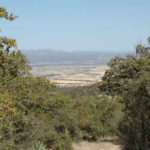Knapweed – Pretty but harmful
Although it isn’t a major problem in this little corner of Arizona, there is one wee d that has been spreading hate and destruction across the western States since the late 1800s. Its called Knapweed. There are several varieties and you’ve probably seen it along roadsides, next to pond, beside railroad tracks, and just about anyplace where the land has been disturbed. Knapweed is free of diseases, insects, and enemies to keep it in check. Plus, it has a secret weapon it uses against other plants – its roots secretes a chemical that kills other plants, removing all the competition. All these factors contribute to Knapweeds fast spreading nature.
d that has been spreading hate and destruction across the western States since the late 1800s. Its called Knapweed. There are several varieties and you’ve probably seen it along roadsides, next to pond, beside railroad tracks, and just about anyplace where the land has been disturbed. Knapweed is free of diseases, insects, and enemies to keep it in check. Plus, it has a secret weapon it uses against other plants – its roots secretes a chemical that kills other plants, removing all the competition. All these factors contribute to Knapweeds fast spreading nature.
Methods to keep Knapweed under control range from annual application of weed killing chemicals to hand pulling. Long-term grazing by sheep and goats has been found to control Knapweed but it is still considered a serious problem and unwanted invasive weed in most western States.
What can you, as a private citizen or homeowner or hiker, do to help control the spread of Knapweed? My greatest concern would be misidentifying another plant for the Knapweed and pulling the wanted for the unwanted. So, unless you can get some type of training from a person who is knowledgeable, I would recommend practicing thoughtful trail use.
– Stay on the trail so you don’t pick up and carry Knapweed or other weed seeds to un-infected areas.
– Clean boots, clothes, backpack, and camping equipment of debris, again to reduce the chance of spreading weed seeds.
– If a equestrian, used only weed-free feed.
You could also contact your local National Forest or National Grassland folks and see if they are having a “Weed Pulling Gathering.”
To be honest, Knapweed can be pretty. It’s many purple, pink, or blue flowers on top of a spindly bush adds color to an often dull landscape. But its impact on the surrounding eco-system is anything but pretty. If we can’t get rid of it, let us try to at least control this pretty but harmful plant.
+++++++++++++++++++++++++++++++++++++++++++++++++
A Favorite “One man’s plant is another man’s weed” Story – When the Brooklyn Shipyard closed back in the 19 60s, some of its employees moved from the big city to the country hamlet of Bowie, MD. Many of the new homes were built near a woodland but some weren’t. One gentleman, who’s home wasn’t along the woodland, decided he wanted the woodland’s natural feel so, wandered through the woods until he found a leafy green vine he thought was attractive. He dug up several plants, brought them home, and planted them along his chainlink fence. He careful watered his new plants, weaving new growth into the fence, and developing a nature hedge. It was several months before a neighbor asked the homeowner what he had done to offend his neighbor. “Why” the neighbor wanted to know, “did you plant Poison Ivy on the fence that separated their yards?” The moral: One man’s beloved plant could be another’s weed.
60s, some of its employees moved from the big city to the country hamlet of Bowie, MD. Many of the new homes were built near a woodland but some weren’t. One gentleman, who’s home wasn’t along the woodland, decided he wanted the woodland’s natural feel so, wandered through the woods until he found a leafy green vine he thought was attractive. He dug up several plants, brought them home, and planted them along his chainlink fence. He careful watered his new plants, weaving new growth into the fence, and developing a nature hedge. It was several months before a neighbor asked the homeowner what he had done to offend his neighbor. “Why” the neighbor wanted to know, “did you plant Poison Ivy on the fence that separated their yards?” The moral: One man’s beloved plant could be another’s weed.






